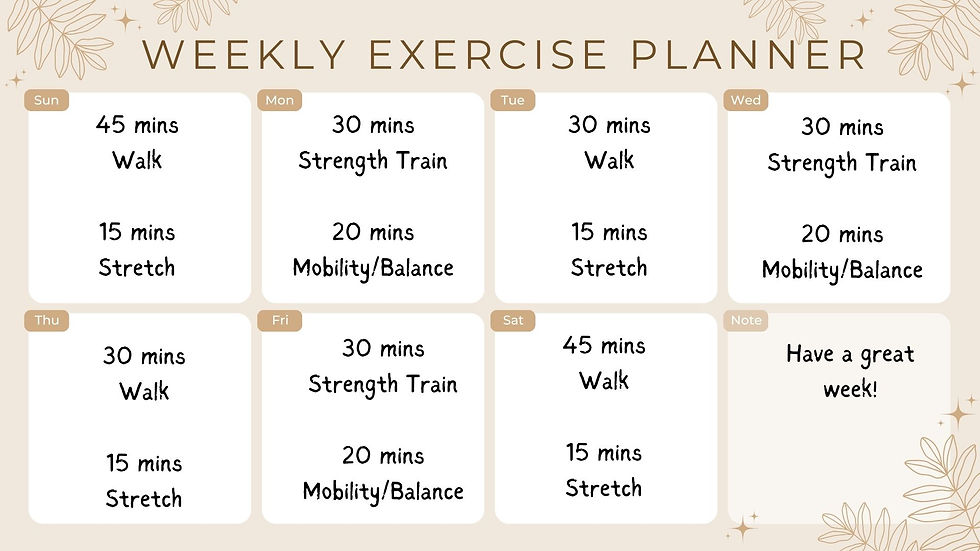Question: What do all the following have in common?
The American Heart Association (AHA), the Center for Disease Control and Prevention (CDC), the U.S. Department of Health and Human Services (HHS), American Council on Exercise (ACE), the American College of Sports Medicine (ACSM) the American College of Obstetricians and Gynecologists (OCOG), the educational posters in your doctor’s office, and countless research articles, etc.
Answer: All these organizations, and countless others that conduct health research, make recommendations for maintaining health and preventing diseases including diabetes (high blood sugar), osteoporosis (brittle bones), hypertension (high blood pressure), hypercholesterolemia (high cholesterol), and even certain cancers. And every single one of these organizations makes very similar recommendations, EXERCISE.
Most research concludes specific quantities, time recommendations and volume of exercise for building strength and stamina, improving balance and mobility, and reducing risk of the above-mentioned diseases.
The recommendations for weekly exercise include 5 key essential components:
1. 150 minutes or more of moderate aerobic activity per week.
2. 2-3 days of muscle strengthening exercises
3. Balance training 3 times per week (specifically for older adults at risk of falls)
4. Flexibility training 2-4 times per week
5. Mobility training as often as possible
If you get the recommended weekly exercises, how might this look in your schedule?

Getting the recommended forms of movement for disease prevention and maintaining your health may be no problem for you. Congratulations! But, unfortunately, if you do meet the exercise recommendations, you are in the minority. According to the CDC, the percentage of adults age 18 and older who meet the physical activity guidelines for both aerobic and muscle strengthening active is only 24.2%!
That statistic breaks my heart and is one of the main factors that compelled me to dedicate my career to fitness and exercise.
Over the years that I’ve been a fitness instructor, I’ve been privileged and grateful to help people improve markers of health, decrease their perscription medications, lose weight, increase their strength and mobility making daily activities easier, help relieve aches and pains, improve the way they feel about how they look and their sense of overall wellbeing.
If you haven’t done much exercise in a while, that above sample schedule and all those recommendations may look really daunting! When starting a new fitness plan, it’s easy to feel overwhelmed, especially if you try to add too many components all at once. I’ve seen this happen every year with new members at the gym who start with lots of excitement at the beginning of January. Maybe they found a “30-DAY FITNESS CHALLENGE” online but only make it to day 5, and then the momentum is quickly lost and progress halts if the routine is not sustainable. Or when too many activities are added at once which can lead to feeling overly fatigued, sore, and discouraged. But it doens't have to be this way!
Many of my personal training clients have found success in making lasting fitness changes by focusing on one component of fitness at a time, and then progress at a pace that is best for them. Some people find it’s best to work on corrective exercise first so as not to exacerbate any underlying imbalances. Others focus on adding more cardiovascular training like daily walks for heart health or weightloss, while some of my clients concentrate first on building more core strength to help alleviate back pain. Then we progress by adding other elements of fitness such as mobility and balance training to reduce the risk of falls, or a full body strength routine with specific exercises to make life easier. Together, we craft sustainable fitness routines to include all 5 key components!
Focus on one component of fitness, make it a habit, and then build on that momentum. When starting a new routine, ask yourself: what component of exercise would be most beneficial for you to start with to make part of your weekly routine? Make small adjustments at a pace that is right for you and build on those great habits for sustainable changes.
How will you maximize the health benefits of these 5 components of your weekly exercise routine?
1. Aerobic Activity
2. Strength Training
3. Balance Training
4. Flexibility Exercises
5. Mobility Exercises
If you want to reduce your risk of disease, improve your stamina, strength, or mobility, and are just not sure where to start, please reach out if you need guidance in creating a sustainable fitness routine that can be progressed at your pace and meet your needs.
References
American Heart Association Recommendations for Physical Activity in Adults and Kids. (2023). Retrieved from https://www.heart.org/en/healthy-living/fitness/fitness-basics/aha-recs-for-physical-activity-in-adults.
Artese, A. Planning the Perfect Fitness Week (2018). Retrieved from https://www.acefitness.org/resources/pros/expert-articles/7166/planning-the-perfect-fitness-week/.
Elgaddal, N. et al. Physical Activity Among Adults Aged 18 and Over: United States, 2020. (2022) Retrieved from https://www.cdc.gov/nchs/data/databriefs/db443.pdf.
U.S. Department of Health and Human Services (2018). Physical Activity Guidelines for Americans (2nd ed.). Washington, D.C.: U.S. Department of Health and Human Services. Retrieved from https://health.gov/sites/default/files/2019-09/Physical_Activity_Guidelines_2nd_edition.pdf.
Comments